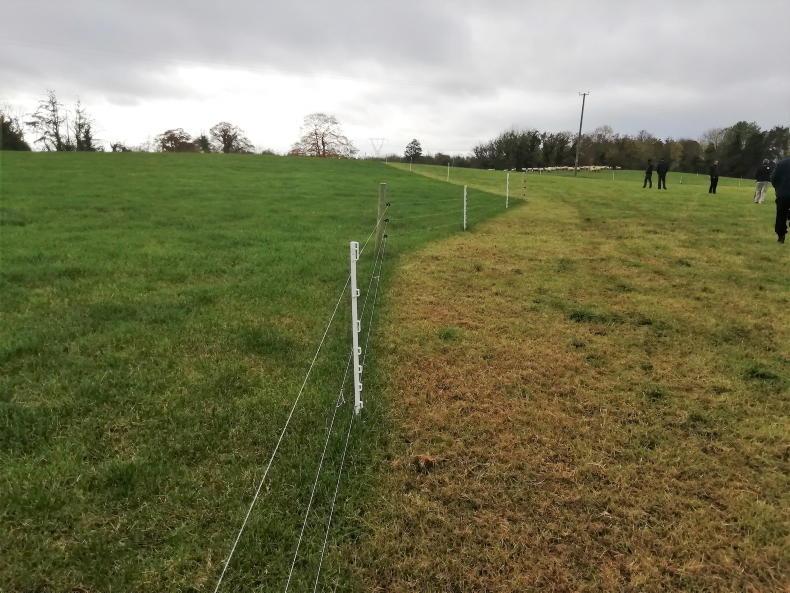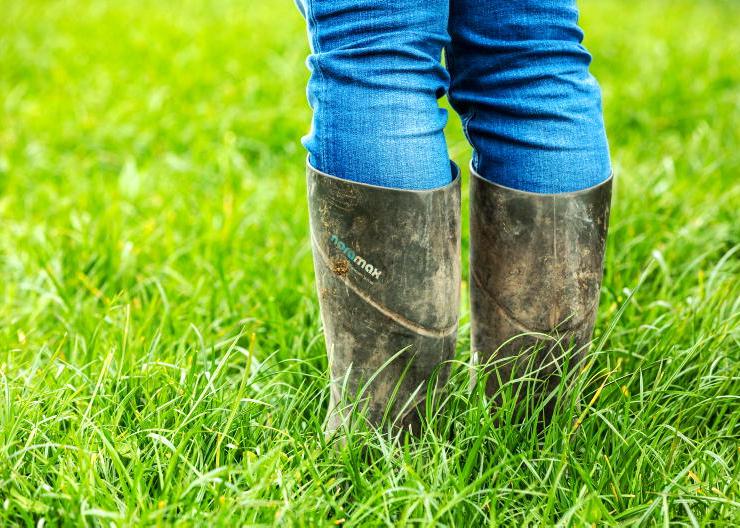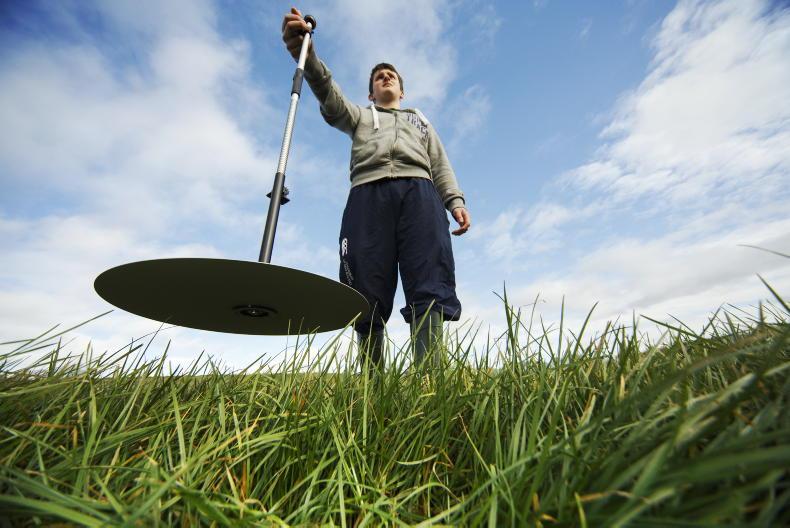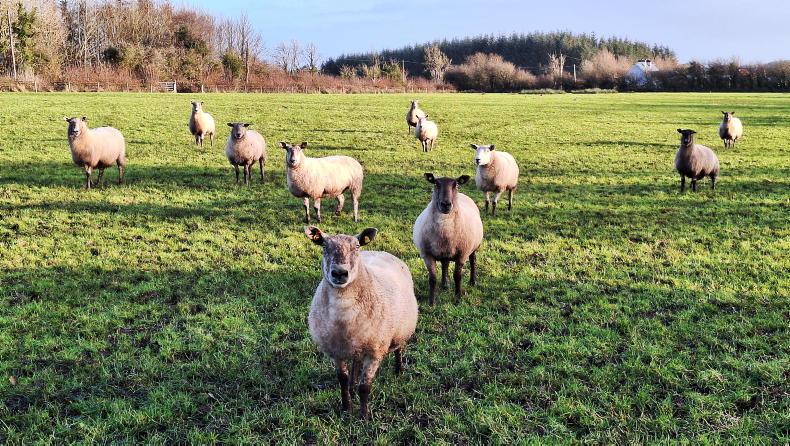Lambing for the lowland Teagasc BETTER farm sheep flocks is all but complete at this stage and the focus has firmly turned to ensuring the flock is performing at grass.
Grass growth during the month of April has been variable with cold weather for the time of year and frost at night slowing grass growth.
Currently, grass supplies across the farms are on target but careful management is required to ensure this remains the case, particularly on farms with higher stocking rates and high grass demand at this time of year.
Starting the year with adequate grass supplies is essential to ensure that grazing management and flock performance can be optimised.
Second rounds of fertiliser are going on at present
The benefits of having an autumn closing plan become very clear in spring and none more so than this spring where despite weather and soil conditions delaying first fertiliser applications until the first week of March, average farm cover for most of the flocks was on target.
Second rounds of fertiliser are going on at present with most of the flocks going with one bag of 18:6:12 per acre for grazing ground.
Grazing groups
A key management task during the last couple of weeks has been grouping ewes and lambs into larger grazing groups and using temporary divisions where necessary to improve grass utilisation, reduce residency times in paddocks and to give paddocks a chance to recover ahead of the next round of grazing.

Batching ewes and lambs into their grazing groups and keeping the grazing rotation on track will help reduce the recovery time once growth rates increase.
The temptation is always there to leave ewes and lambs in smaller groups but once lambs are a couple of weeks old the number of groups on the farm needs to be reduced.
Not grouping up leads to large parts of the farm being grazed at the same time, which reduces overall grass growth on the farm and depletes the average farm cover.
This becomes particularly important as grass demand rises in early lactation with the current situation of grass growth rates being significantly lower than demand for a lot of farmers.
Silage ground
Some of the flocks have also started closing off paddocks for silage but unless grass growth rates increase in the coming week, some flocks may need to re-graze some of this ground in order to maintain grass in front of stock.
Supplementation will help to extend the grazing rotation
The target for this time of year is 20 days ahead and the average for the group is currently 21 based on last week’s grass measurements.
Supplementation will help to extend the grazing rotation and avoid running out of grass before grass growth rates improve but this comes at a cost and means extra labour at an already busy time, so it will only be done where necessary.
Also, at this stage of the year, most of the lowland flocks will have passed peak milk yield in the ewes so supplementation, if needed, will be targeted at the lambs rather than the ewes.
Regular monitoring
The programme participants are using PastureBase Ireland and this data is invaluable throughout the year for making grazing decisions, but particularly at times when grass supply and demand is finely balanced.
Grass growth rates for the second week of April were averaging 27kg DM/ha/day but there was a wide range in this going from 11kg DM/ha up to 57kg DM/ha, highlighting the importance of each farmer walking his own farm before making grazing decisions.
At times like this, it is important to carry out a regular assessment of grass growth and supplies to be in a position to make any required changes fast.
Lambing for the lowland Teagasc BETTER farm sheep flocks is all but complete at this stage and the focus has firmly turned to ensuring the flock is performing at grass.
Grass growth during the month of April has been variable with cold weather for the time of year and frost at night slowing grass growth.
Currently, grass supplies across the farms are on target but careful management is required to ensure this remains the case, particularly on farms with higher stocking rates and high grass demand at this time of year.
Starting the year with adequate grass supplies is essential to ensure that grazing management and flock performance can be optimised.
Second rounds of fertiliser are going on at present
The benefits of having an autumn closing plan become very clear in spring and none more so than this spring where despite weather and soil conditions delaying first fertiliser applications until the first week of March, average farm cover for most of the flocks was on target.
Second rounds of fertiliser are going on at present with most of the flocks going with one bag of 18:6:12 per acre for grazing ground.
Grazing groups
A key management task during the last couple of weeks has been grouping ewes and lambs into larger grazing groups and using temporary divisions where necessary to improve grass utilisation, reduce residency times in paddocks and to give paddocks a chance to recover ahead of the next round of grazing.

Batching ewes and lambs into their grazing groups and keeping the grazing rotation on track will help reduce the recovery time once growth rates increase.
The temptation is always there to leave ewes and lambs in smaller groups but once lambs are a couple of weeks old the number of groups on the farm needs to be reduced.
Not grouping up leads to large parts of the farm being grazed at the same time, which reduces overall grass growth on the farm and depletes the average farm cover.
This becomes particularly important as grass demand rises in early lactation with the current situation of grass growth rates being significantly lower than demand for a lot of farmers.
Silage ground
Some of the flocks have also started closing off paddocks for silage but unless grass growth rates increase in the coming week, some flocks may need to re-graze some of this ground in order to maintain grass in front of stock.
Supplementation will help to extend the grazing rotation
The target for this time of year is 20 days ahead and the average for the group is currently 21 based on last week’s grass measurements.
Supplementation will help to extend the grazing rotation and avoid running out of grass before grass growth rates improve but this comes at a cost and means extra labour at an already busy time, so it will only be done where necessary.
Also, at this stage of the year, most of the lowland flocks will have passed peak milk yield in the ewes so supplementation, if needed, will be targeted at the lambs rather than the ewes.
Regular monitoring
The programme participants are using PastureBase Ireland and this data is invaluable throughout the year for making grazing decisions, but particularly at times when grass supply and demand is finely balanced.
Grass growth rates for the second week of April were averaging 27kg DM/ha/day but there was a wide range in this going from 11kg DM/ha up to 57kg DM/ha, highlighting the importance of each farmer walking his own farm before making grazing decisions.
At times like this, it is important to carry out a regular assessment of grass growth and supplies to be in a position to make any required changes fast.











SHARING OPTIONS